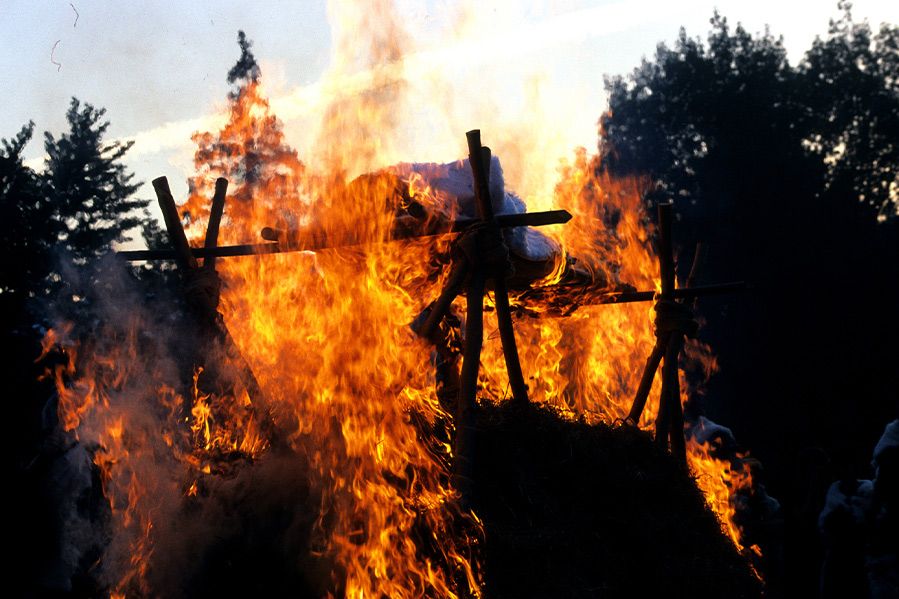
When you consider the history of the Earth, the average lifespan of a loved one often seems fleeting in comparison. Our connections with loved ones are so strong that we look for special ways to celebrate their lives when they pass. Just as with weddings, there is no single way to honor the memory of the deceased. In Western society, most bodies are handled formally through burials or cremations. The funeral pyre is likely something you’ve seen depicted in media, but is it a realistic and legal way to celebrate the dead?
What Is a Funeral Pyre?
Funeral pyres are simply structures built to burn the deceased as part of a final ritual. Taken from the Greek word for fire, a pyre can be thought of as a cremation that takes place out in the open. The earliest evidence of funeral pyres can be found in prehistoric times, with examples from Europe, Asia, and Australia. Ancient societies often built pyres or altars for animal sacrifices to various deities. In many cultures, fire holds symbolic significance, representing purification, transformation, and the journey of the soul to the afterlife. Some examples of the roots of funeral pyres include the following:
- In ancient India, Hinduism practiced “agnihotra,” which involved cremating the deceased while offering prayers to Agni, the deity of fire, specifically the hearth of the home and the funeral pyre.
- Greeks and Romans often honored their heroes by burning their bodies on pyres, sending them on a final journey.
- A Viking funeral pyre is often shown in popular culture as a death rite. These are often shown as elaborate structures built in honor of respected warriors.
Are Pyres Always Religious?
Funeral pyres don’t always have a religious context. Although some Hindus and Sikhs still honor the dead with a pyre funeral, pyres or open-air cremations have secular contexts:
- Bonfires: These large, controlled outdoor fires are often built for ceremonial purposes, acknowledging the deceased or the anniversary of a death.
- Disposal of Bodies: Pyres have been used to cremate several bodies at once, such as those of enslaved Africans in the Americas or concentration camp prisoners in Nazi Germany.
- Disposal of Livestock: Pyres were also used to dispose of livestock, especially large quantities of animals infected by disease.
Are Funeral Pyres Legal or Practical?
The legality and practice of funeral pyres vary globally. In the United States, funeral pyres are not a common practice for several reasons:
- Excessive Heat: The average temperature of a house fire is 1,000 degrees Fahrenheit. Cremating a body requires a fire that can burn at 2,012 degrees Fahrenheit for a minimum of two hours. It is difficult to safely generate a fire with that intensity for a pyre.
- Body Disposal Regulations: The disposal of a body is strictly regulated in most countries. Fires usually aren’t hot enough to properly cremate a body. Most crematoriums have to grind the bones of the deceased. If you were to put a body on a floating pyre, it would likely wash up onshore somewhere long before it could be completely burned.
- Environmental Effects: On average, a pyre involves six hours of burning and over 1,000 pounds of wood. This harms the environment, including air pollution, water pollution (from ash disposal), deforestation, and greenhouse gas emissions.
American attitudes towards death and final rites are significantly influenced by European traditions, which heavily favor burials over cremation. Although cremations are legal and well-regulated, some people consider them taboo. Modern crematoriums often have electrical furnaces that are much more efficient at burning bodies with less impact on the environment.
Are Funeral Pyres Legal in the U.S.?
Generally, pyres that involve corpses are illegal stateside, but there are exceptions. The Crestone End of Life Project (CEOLP) is a volunteer group that operates one of the only legal, open-air cremation sites in Colorado. Inspired by the end-of-life rituals of ancient societies, the process involves a pyre, a wooden stretcher, a shroud, and a half-cord of wood. The CEOLP conducts these non-sectarian, community-driven ceremonies up to 12 times annually, extending opportunities for participation to families.
Funeral pyres hold a special place in the history of humankind and its various cultural narratives. The future of this practice requires a balancing of cultural customs with environmental and legal considerations. Understanding their origins and how they’re practiced throughout history provides insight into diverse perspectives on death, the afterlife, and faith.



